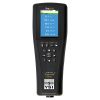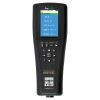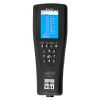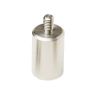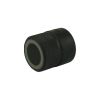Used YSI ODO/T Probe & Cable Assembly
Features
- One–cable design for easy dissolved oxygen measurements in the field
- Rugged probe and cable designed for field work
- Sensors store calibration data, so probe assemblies can be swapped between handhelds without the need for re-calibration
- Free ground shipping
- Expedited repair and warranty service
- Lifetime technical support
- More
Overall
The YSI ODO/T probe assembly pairs with the ProSolo Handheld to form a complete sampling system. Featuring integral, digital sensors, the ODO/T is plug-and-play which minimizes time spent on instrument setup. ProDIGITAL technology allows the handheld to automatically recognize connected sensors, so there is no need to tell the instrument what is connected.
Non-Consumptive Technology
The YSI ODO/T probe's technology is non-consumptive, meaning oxygen is not consumed during the measurement. Flow dependence is non-existent, and no stirring is required. The ODO sensor is not susceptible to interferences from other gases, drifts less and holds calibration longer than membrane-covered sensors. Maintenance is a breeze with a simple, threaded optical cap that is good for at least two years.
ProDIGITAL ODO/T Benefits
- Integral optical dissolved oxygen, and temperature sensors that are auto-recognized by Pro DIGITAL handhelds, reducing instrument set-up time
- Rugged Optical DO sensor cap with a 2-year warranty is pre-installed on new assemblies
- Military Spec (MS) connector and a weighted, stainless steel probe guard
- Fits in a 1-inch well with cable lengths up to 100 meters
In The News
Monitoring Meadowbrook Creek: Real-Time Data Collection in an Urban Creek
Meadowbrook Creek in Syracuse, New York, has been monitored by Syracuse University (SU) faculty and students for over a decade. Originally established by Dr. Laura Lautz in 2012, the early years of the program focused on collecting grab water samples for laboratory analysis and evaluating the impact of urban land use, human activities, and natural processes on water resources. Tao Wen , an Assistant Professor in SU’s Department of Earth and Environmental Sciences, took over the program in 2020 and upgraded the existing systems to include 4G modems that allowed for real-time data viewing. [caption id="attachment_39339" align="alignnone" width="940"] An overview of the Fellows Ave monitoring station along Meadowbrook Creek.
Read MoreLancaster County Makes the Switch to Real-Time Water Quality Monitoring Systems
Continuous data collection in Lancaster County, Pennsylvania, started about 5 years ago, and the county will be making a major upgrade over the next year—switching from relying solely on the internal storage of water quality sondes to telemetry units that enable real-time data viewing. [caption id="attachment_39295" align="alignnone" width="940"] The first telemetry unit was installed at LCCD along Little Conestoga Creek. (Credit: Tyler Keefer / LCCD) [/caption] Telling Lancaster County's Story Through Data Since the Lancaster County Conservation District started monitoring county waterways, the goal has remained the same, according to Amanda Goldsmith, Watershed Specialist for the Watershed Department.
Read MoreFrom Florida to the World: How a Smithsonian Research Station is Bridging Gaps in Marine Biology
In the early 2000s, along the coast of northern California, where the redwoods dominate the forests, and the Pacific Ocean shapes shorelines, a Humboldt University undergraduate student took the first steps into a lifelong love of marine biology. Dean Janiak accepted an invitation to help a graduate student with fieldwork in rocky coastal tide pools, and so began a journey that led him from California to Connecticut to Florida and eventually to the world, where he has facilitated research in communities across the globe. While finishing up his masters of Oceanography from the University of Connecticut, Janiak continued researching fouling communities–marine life that live on hard, often artificial surfaces such as docks–at the Smithsonian Environmental Research Center.
Read More









